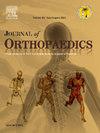Plate, short nail, or long nail? Revision rates and complications of three different treatments for peritrochanteric femur fractures
IF 1.5
Q3 ORTHOPEDICS
引用次数: 0
Abstract
Background
We sought to investigate the relationship between peritrochanteric femur fracture (OTA 31A fractures) fixation and rates of peri-implant fracture, rates of transfusion, and the rates of increased dependence after secondary surgery for fracture for short cephalomedullary nails (SCMN), long cephalomedullary nails (LCMN), and plate and screw devices (PSD).
Methods
Multi center retrospective study involving data collected from 151 Level I-IV trauma centers using ICD9/10 and CPT codes for identification. 13,197 patients with peritrochanteric femur fractures between 2016 and 2021 were included in analysis.
Results
We report no significant difference in peri-implant fractures in extramedullary and intramedullary devices (LCMN 50, 0.84 %; SCMN 57, 0.88 %; PSD 6, 0.74 %; p = 0.91) as well as no significant difference in the rates of discharge to home after surgical fixation of a peri-implant fracture.
Conclusions
There is no difference in peri-implant fracture rates between SCMN, LCMN, and PSD methods of fixation for peritrochanteric femur fractures. Therefore, longer implants do not seem to protect the femur from future peri-implant fracture when compared to shorter implants. Further analysis is needed to more fully elucidate the morbidity associated with readmission and revision of peri-implant fractures following fixation of peritrochanteric femur fractures.
Level of evidence
Therapeutic Level III.
钢板、短钉还是长钉?股骨转子周围骨折三种不同治疗方法的翻修率和并发症
背景我们试图调查股骨转子周围骨折(OTA 31A 骨折)固定与植入物周围骨折率、输血率以及骨折二次手术后依赖性增加率之间的关系,包括短头髓内钉(SCMN)、长头髓内钉(LCMN)以及钢板和螺钉装置(PSD)。方法多中心回顾性研究,涉及从 151 个一级至四级创伤中心收集的数据,使用 ICD9/10 和 CPT 编码进行识别。结果我们发现髓外装置和髓内装置的植入周围骨折无显著差异(LCMN 50, 0.84 %; SCMN 57, 0.88 %; PSD 6, 0.74 %; p = 0.结论股骨转子周围骨折的 SCMN、LCMN 和 PSD 固定方法在假体周围骨折发生率方面没有差异。因此,与较短的植入物相比,较长的植入物似乎并不能保护股骨免受未来植入物周围骨折的影响。还需要进一步分析,以更全面地阐明股骨转子周围骨折固定后与再入院和植入物周围骨折翻修相关的发病率。
本文章由计算机程序翻译,如有差异,请以英文原文为准。
求助全文
约1分钟内获得全文
求助全文
来源期刊

Journal of orthopaedics
ORTHOPEDICS-
CiteScore
3.50
自引率
6.70%
发文量
202
审稿时长
56 days
期刊介绍:
Journal of Orthopaedics aims to be a leading journal in orthopaedics and contribute towards the improvement of quality of orthopedic health care. The journal publishes original research work and review articles related to different aspects of orthopaedics including Arthroplasty, Arthroscopy, Sports Medicine, Trauma, Spine and Spinal deformities, Pediatric orthopaedics, limb reconstruction procedures, hand surgery, and orthopaedic oncology. It also publishes articles on continuing education, health-related information, case reports and letters to the editor. It is requested to note that the journal has an international readership and all submissions should be aimed at specifying something about the setting in which the work was conducted. Authors must also provide any specific reasons for the research and also provide an elaborate description of the results.
 求助内容:
求助内容: 应助结果提醒方式:
应助结果提醒方式:


